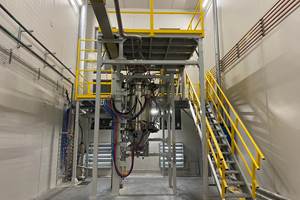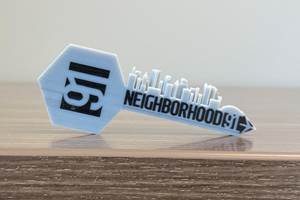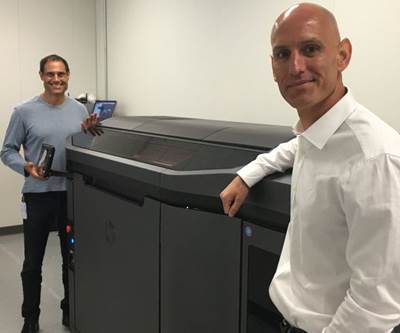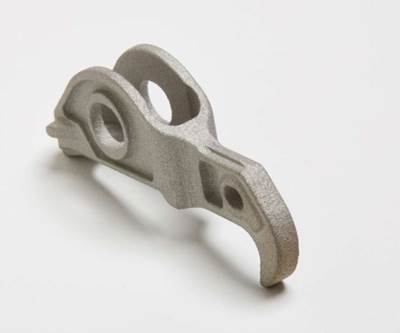Overcoming Obstacles to Bring AM into the Supply Chain
A conversation with Jabil’s John Dulchinos and HP’s Stephen Nigro illustrates some of the challenges in integrating additive manufacturing into a supply chain for production parts.
With its continued pursuit of additive manufacturing (AM) on an interconnected, global scale, Jabil is perhaps HP's most ambitious customer. The global manufacturing service provider’s recent installation of six additional HP Multi Jet Fusion (MJF) 3D printers at a facility in Singapore is significant not just for the equipment investment it represents, but for the role that these printers will play in the newly launched Jabil Additive Manufacturing Network. The AM Network, which contains Jabil AM operations around the world, is an endeavor to align all parts of the AM process from product development through to part production and delivery into a global supply chain, connected by a digital thread.
Yet bringing additive manufacturing into a streamlined supply chain does not come without challenges. When I spoke with John Dulchinos, vice president of digital manufacturing at Jabil, and Stephen Nigro, president of HP's 3D Printing business, at Rapid + TCT 2018 about the obstacles to be overcome in creating a true AM supply chain, I discovered that many of them are just as applicable to small- to medium-sized businesses as they are to large companies like Jabil.
Beyond just mastering the technology, “We’re now encouraging people to think about what it takes to bring AM into production,” Nigro says. In the conversation this past April, he summarized three organizational requirements: a desire to implement AM, an investment in training and mindset, and the right applications.
Implementation Is Disruptive
The first step in incorporating additive manufacturing into a supply chain is marshalling the will to do so—which is not always easy. The difficulty is not just in convincing manufacturers that 3D printing is robust enough to support production. Citing the MJF platform as an example, Nigro points out that the system continues to advance in terms of the production applications in which it has proven viable. Yet even where the case has been made, the nature of the technology itself requires different treatment from whatever technology came previously.
“3D printing is not injection molding—for both good and bad. You can’t make it a one-to-one replacement.”
“3D printing is not injection molding—for both good and bad,” Dulchinos says. “You can’t make it a one-to-one replacement.” Incorporating 3D printing into the supply chain is disruptive not just because the technology is different, but because it also requires a different mindset—one that considers 3D printing as an option from the beginning and constructs processes around it, rather than substituting it for another technology.
One example comes directly from Jabil’s relationship with HP. Jabil is unique in that the company manufactures parts for Multi Jet Fusion printers, which it produces using those very same printers. More than 140 parts for the new full-color MJF 300 / 500 series 3D printers are made this way (some of which are pictured above), including many that would be impossible to make by injection molding. Some parts are even designed to be nested within one another, making it possible to efficiently produce a variety of parts simultaneously. Implementing 3D printing as the production technology in this supply chain has meant completely rethinking part design and workflow.
Training and Mindset Matter
As a result, manufacturers who incorporate 3D printing for production must also invest in training for the existing and future workforce. One immediate area of need is design for additive manufacturing (DFAM) training. Design engineers must learn how to optimize for 3D printing by departing from traditional manufacturing conventions in order to reduce the amount of material used in parts and consolidate assemblies, among other strategies. These design considerations aren’t just an accommodation made to additive; instead, they represent opportunities to improve parts, by reducing weight or eliminating connection points, for instance.
“Every time you put two parts together as an assembly, it’s an opportunity for failure,” Dulchinos says. The MJF parts that Jabil produces today include many single components that were once multiple pieces. The combined parts would be difficult or even impossible to manufacture as one piece with injection molding or machining, but they can easily be printed together.
Starting with DFAM in mind will help manufacturers better leverage the technology in part designs, but also make 3D printing a more solid step in the supply chain. “In the future, it’s not component-level. It’s system-level,” Dulchinos adds.
Meeting Applications Is a Two-Way Street
As Nigro notes, HP has been investing more in application expertise, with an increased emphasis on very specific customer requirements. Unless 3D printing can meet those requirements, it won’t fit into a customer’s supply chain. But, finding the right applications is a two-way street. “Every 3D-printed part today has a story behind it,” Dulchinos says, and often that story today includes supplier-side advancements in hardware, software or materials to support that particular application.”
Materials development offers one illustration: “Customers are buying a set of properties, not material,” Dulchinos says. Material suppliers like HP therefore have to start not with specific materials, but with specific characteristics that users want for specific functionality, and be able to offer material options that allow 3D printing to achieve those end-user aims.
Related Content
Can the U.S. Become Self-Sufficient in Aerospace Alloy Metal Powders?
6K’s technology can upcycle titanium and nickel-alloy parts into additive manufacturing powder. Here is how the circular economy helps national security.
Read MoreWhat Is Neighborhood 91?
With its first building completely occupied, the N91 campus is on its way to becoming an end-to-end ecosystem for production additive manufacturing. Updates from the Pittsburgh initiative.
Read MoreNext-Gen Horse Trailers to Be Built With Robotic 3D Printing
Double D Trailers is currently developing a prototype horse trailer that will be made with large-format additive manufacturing. The technology brings potential benefits for labor, weight and design features to this subset of recreational vehicles.
Read MoreVariable Resistance Valve Trim Achieves Lead Time Reduction Through AM: The Cool Parts Show #69
Baker Hughes is realizing shorter lead times and simplified manufacturing through powder bed fusion to produce valve trims previously assembled from many machined metal parts.
Read MoreRead Next
Jabil Moves Toward Production with HP Additive Manufacturing Technology
As the first manufacturer to accept delivery of HP Jet Fusion 3D printers, Jabil has its sights set on additive production at scale.
Read MoreHow to Implement Additive Manufacturing Across a Global Company: 5 Lessons
With more than 100 facilities and about 200,000 employees worldwide, Flex has a steep challenge in bringing 3D printing into its operations. Five things the company is learning.
Read MoreFrom Functional Parts to Lots of Functional Parts, AM Is Advancing into Production Scale
The assumption that additive is only for low-volume manufacturing is about to give way. Read these stories of companies getting ready for additive production at larger scales.
Read More
.jpg;width=70;height=70;mode=crop)


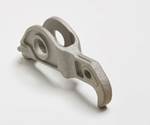








.png;maxWidth=300;quality=90)



